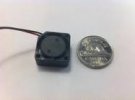- Joined
- May 1, 2013
- Messages
- 10,668
- Reaction score
- 6,561
- Location
- Dublin
- Country
- Ireland
- Dash Cam
- Street Guardian UK / EU / EEA Distributor
Heat has physical substance to move up as we know. So i guess if mobius mounted with buttons and heat sink down, which is logical for operating a menu buttons, but then a lot of heat "goes" up, back to the main board.
Maybe try mount mobius heat sink facing up. See what then happens.
Maybe try mount mobius heat sink facing up. See what then happens.




